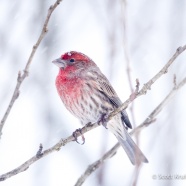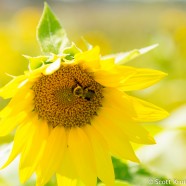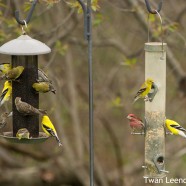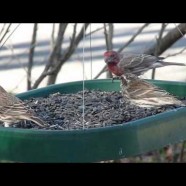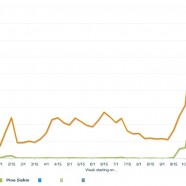Male House Finch
Here is a recent photo of a male House Finch (Haemorhous mexicanus) on a snowy afternoon. The beautiful red shades of this guy really stand out against the drab surroundings, and their cheery songs can already be heard here in February on some of the warmer, sunnier days. It is one of the first signs of “spring” as the days began to grow longer. The Purple Finch (Haemorhous purpureus) is a similar species and often confused with the House Finch, especially because both enjoy coming to backyard bird feeders. Roger Tory Peterson described the Purple Finch as having been...
Read MoreInsects to Birds
It is starting to get darker earlier each day. The sunflowers are growing in height. The insects are peaking, and our bees will be slowing down shortly. For now the flowers are feeding the bugs, but soon enough they will be transitioning to feeding all of the birds pouring down to the south, with the later arriving seed eaters ready to feast on sunflowers right out of the garden. Is it going to be a large irruptive season for the winter finches? While it is too soon to tell for certain, some Red-breasted Nuthatches and Purple Finches seen out of place to the south in a few places late this...
Read MoreFeeder Finches
There are three kinds of finches in these photos, and the views afford a great perspective of their relative sizes. The American Goldfinch, Pine Siskin and Purple Finch were all visitors to Twan’s yard recently. The Purple has such an enormous bill!
Read MorePurple Finch vs House Finch comparison with feeder birds
Here we have a female Purple Finch (Haemorhous purpureus) feeding throughout the video along with a female House Finch (Haemorhous mexicanus) and a male House Finch later on. A Tufted Titmouse (Baeolophus bicolor) and Black-capped Chickadee (Poecile atricapillus) also make an appearance among the common feeder birds visiting this tray of sunflower seeds. Note that the female Purple Finch is larger and bulkier than her House Finch counterpart. She has more boldly defined colors in all regards with additional heavier and stronger facial and head markings. Take a few watches to get a feel for...
Read MorePurple Finch and Pine Siskin invasion
Two species have recently flooded the Northeast and Mid-Atlantic according to list serv reports, accounts from friends and my own personal observations – the Purple Finch and the Pine Siskin. The former has been unbelievably abundant in my experience, often being difficult to go outside for any length of time without seeing one in the past month. The latter, while a bit tougher to spot, has nonetheless zipped by in sizable groups and maintained their nomadic feeding habits. Just how massive are these irruptions in our region? I turned to eBird to find out the truth. Here are both...
Read More



